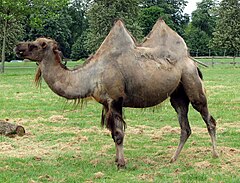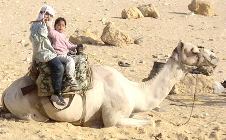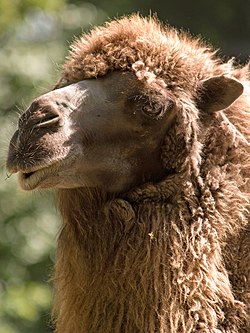Camel: Difference between revisions
Reverting possible vandalism by Special:Contributions/58.165.25.254 (see here). If this is a mistake, report it. Thanks, ClueBot. (Bot) |
No edit summary |
||
| Line 42: | Line 42: | ||
The almost 14 million [[Dromedary|Dromedaries]] alive today are domesticated animals (mostly living in [[Somalia]], [[Sudan]], [[Mauritania]] and nearby countries). |
The almost 14 million [[Dromedary|Dromedaries]] alive today are domesticated animals (mostly living in [[Somalia]], [[Sudan]], [[Mauritania]] and nearby countries). |
||
The [[Bactrian Camel]] once had an enormous range, but is now reduced to an estimated 1.4 million animals, mostly domesticated. It is thought that there are about 1000 wild Bactrian Camels in the [[Gobi Desert |
The [[Bactrian Camel]] once had an enormous range, but is now reduced to an estimated 1.4 million animals, mostly domesticated. It is thought that there are about 1000 wild Bactrian Camels in the [[Gobi Desert. |
||
There is a substantial [[feral]] population estimated at up to 700,000 in central parts of [[Australia]], descended from individuals introduced as means of transport in the [[19th century]] and early [[20th century]]. This population is growing at approximately 11% per year and in recent times the state government of [[South Australia]] has decided to cull the animals using aerial marksmen, because the camels use too much of the limited resources needed by [[sheep]] farmers. For more information, see [[Australian feral camel]]. A small population of introduced camels, Dromedaries and Bactrians, survived in the [[Southwest United States]] until the [[1900s]]. These animals, imported from Turkey, were part of the [[US Camel Corps]] experiment and used as draft animals in mines, and escaped or were released after the project was terminated. A descendant of one of these was seen by a backpacker in [[Los Padres National Forest]] in 1972. Twenty-three Bactrian camels were brought to Canada during the Cariboo [[Gold Rush]]. |
There is a substantial [[feral]] population estimated at up to 700,000 in central parts of [[Australia]], descended from individuals introduced as means of transport in the [[19th century]] and early [[20th century]]. This population is growing at approximately 11% per year and in recent times the state government of [[South Australia]] has decided to cull the animals using aerial marksmen, because the camels use too much of the limited resources needed by [[sheep]] farmers. For more information, see [[Australian feral camel]]. A small population of introduced camels, Dromedaries and Bactrians, survived in the [[Southwest United States]] until the [[1900s]]. These animals, imported from Turkey, were part of the [[US Camel Corps]] experiment and used as draft animals in mines, and escaped or were released after the project was terminated. A descendant of one of these was seen by a backpacker in [[Los Padres National Forest]] in 1972. Twenty-three Bactrian camels were brought to Canada during the Cariboo [[Gold Rush]]. |
||
Revision as of 10:27, 26 August 2007
| Camels | |
|---|---|

| |
| Bactrian Camel, Camelus bactrianus | |

| |
| Dromedary, Camelus dromedarius | |
| Scientific classification | |
| Kingdom: | |
| Phylum: | |
| Class: | |
| Order: | |
| Family: | |
| Genus: | Camelus Linnaeus, 1758
|
| Species | |
|
Camelus bactrianus | |
Camels are even-toed ungulates in the genus Camelus. The Dromedary or Arabian Camel has a single hump, and the Bactrian Camel has two humps. They are native to the dry and desert areas of western Asia and East Africa, and central and east Asia, respectively. The average life expectancy of a camel is 50 to 60 years. The term camel is also used more broadly to describe any of the six camel-like creatures in the family Camelidae: the two true camels, and the four South American camelids: Llama, Alpaca, Guanaco, and Vicuña.
The name camel comes to English via the Greek κάμηλος (kámēlos) from the Hebrew gamal or Arabic Jamal.
Bactrian camels have two coats: the warm inner coat of down and a rough outer coat which is long and hairy. They shed their fibre in clumps consisting of both coats, which can be gathered and separated. They produce approximately 7 kg (15 lb) of fiber annually. The fibre structure is similar to cashmere wool. The down is usually 2 to 8 cm (1–3 inches) long. While camel down does not felt easily, it may be spun into a yarn for knitting.
A fully-grown adult camel stands 1.85m/6 feet at the shoulder and 2.15m/7 feet at the hump. The hump rises about 30 inches out of its body. Camels can run up to 40mph in short bursts, and sustain speeds of up to 25mph.
Humans first domesticated camels between 3,500–3,000 years ago. The Dromedary and the Bactrian Camel are both still used for milk (which is more nutritious than cow's milk[citation needed]), meat, and as beasts of burden—the Dromedary in western Asia, and the Bactrian Camel further to the north and east in central Asia.
Distribution and numbers
The almost 14 million Dromedaries alive today are domesticated animals (mostly living in Somalia, Sudan, Mauritania and nearby countries).
The Bactrian Camel once had an enormous range, but is now reduced to an estimated 1.4 million animals, mostly domesticated. It is thought that there are about 1000 wild Bactrian Camels in the [[Gobi Desert.
There is a substantial feral population estimated at up to 700,000 in central parts of Australia, descended from individuals introduced as means of transport in the 19th century and early 20th century. This population is growing at approximately 11% per year and in recent times the state government of South Australia has decided to cull the animals using aerial marksmen, because the camels use too much of the limited resources needed by sheep farmers. For more information, see Australian feral camel. A small population of introduced camels, Dromedaries and Bactrians, survived in the Southwest United States until the 1900s. These animals, imported from Turkey, were part of the US Camel Corps experiment and used as draft animals in mines, and escaped or were released after the project was terminated. A descendant of one of these was seen by a backpacker in Los Padres National Forest in 1972. Twenty-three Bactrian camels were brought to Canada during the Cariboo Gold Rush.
Camel hybrids



Bactrian Camels have two humps and are rugged cold-climate camels while Dromedaries have one hump and are desert dwellers. Dromedary hybrids are called Bukhts, are larger than either parent, have a single hump and are good draft camels. The females can be mated back to a Bactrian to produce ¾-bred riding camels. These hybrids are found in Kazakhstan.
The Cama is a camel/llama hybrid bred by scientists who wanted to see how closely related the parent species were. The Dromedary is six times the weight of a Llama, hence artificial insemination was required to impregnate the Llama female (Llama male to Dromedary female attempts have proven unsuccessful). Though born even smaller than a Llama cria, the Cama had the short ears and long tail of a camel, no hump and Llama-like cloven hooves rather than the Dromedary-like pads. At four years old, the Cama became sexually mature and interested in Llama and Guanaco females. A second Cama (female) has since been produced using artificial insemination. Because Camels and Llamas both have 74 chromosomes, scientists hope that the Cama will be fertile. If so, there is potential for increasing size, meat/wool yield and pack/draft ability in South American camels. The Cama apparently inherited the poor temperament of both parents as well as demonstrating the relatedness of the New World and Old World camelids.
Eco-behavioural adaptations
Camels are well known for their humps. They do not, however, store water in them as is commonly believed, though they do serve this purpose through roundabout means. Their humps are a reservoir of fatty tissue. However, when this tissue is metabolised, it is not only a source of energy, but yields through reaction with oxygen from the air 1,111 g of water per 1,000 g of fat converted. Though this metabolization of the fat generates a net loss of water through respiration during the process.
Their ability to withstand long periods without water is due to a series of physiological adaptations, as described below.
Their red blood cells have an oval shape, unlike those of other mammals, which are circular. This is to facilitate their flow in a dehydrated state. These cells are also more stable[1], in order to withstand high osmotic variation without rupturing, when drinking large amounts of water (20-25 gallons in one drink).
The kidneys of a camel are very efficient. Urine comes out as a thick syrup and their feces are so dry that they can fuel fires.
Camels are able to withstand changes in body temperature and water content that would kill most other animals. Their temperature ranges from 34°C (93°F) at night up to 41°C (106°F) at day, and only above this threshold will they begin to sweat. The upper body temperature range is often not reached during the day in milder climatic conditions and therefore the camel may not sweat at all during the day. Evaporation of their sweat takes place at the skin level not at the surface of their coat, thereby being very efficient at cooling the body compared to the amount of water lost through sweating. This ability to fluctuate body temperature and the efficiency of their sweating allows them to preserve about five litres of water a day.
A feature of their nostrils is that a large amount of water vapor in their exhalations is trapped and returned to the camels body fluids, thereby reducing the amount of water lost through respiration.
They can withstand at least 20-25% weight loss due to sweating (most mammals can only withstand about 3-4% dehydration before cardiac failure results from the thickened blood). A camel's blood remains hydrated even though the body fluids are lost; until this 25% limit is reached.
Camels eating green herbage can ingest sufficient moisture in milder conditions to maintain their body's hydrated state without the need for drinking.

A camel's thick coat reflects sunlight. A shorn camel has to sweat 50% more to avoid overheating. It also insulates them from the intense heat that radiates from hot desert sand. Their long legs help by keeping them further from the hot ground. Camels have been known to swim if given the chance.
Their mouth is very sturdy, able to chew thorny desert plants. Long eyelashes and ear hairs, together with sealable nostrils, form an effective barrier against sand. Their pace (moving both legs on one side at the same time) and their widened feet help them move without sinking into the sand.
All member species of the Camelids are known to have a highly unusual immune system, where part of the antibody repertoire is composed of immunoglobulins without light chain[clarification needed]. Whether and how this contributes to their resistance to harsh environments is currently unknown.
Not a behavioral aspect of the camel, but of genuine interest, is the fact that the camel is the only animal to have replaced the wheel (mainly in North Africa) where the wheel had already been established. The camel was not removed from the top of the transport industry in these areas until the wheel was combined with the internal combustion engine in the 20th century.
Camel farming
Military uses of camels

This section needs expansion. You can help by making an edit requestadding to it . |
Attempts have been made to employ camels as cavalry and dragoon mounts and as freight animals in lieu of horses and mules in many regions of the world. In some places, such as Australia, some of the camels have become feral and are considered to be dangerous to travelers on camels. The camels are mostly used in combat because of their hardiness outside of combat and their ability to scare off horses in close ranges. The horses detest the smell of camels and therefore the horses in the vicinity are harder to control. The United States Army had an active camel corps stationed in California in the 19th century, and the brick stables may still be seen at the Benicia Arsenal in Benicia, California, now converted to artist's and artisan's studio spaces. Camels have been used in wars throughout Africa.
Cuisine

Dairy
Camel milk is a staple food of desert nomad tribes and is richer in fat and protein than cow's milk. Camel milk cannot be made into butter in the traditional churning method. It can be made if it is soured first, churned, and then a clarifying agent is added or if it is churned at 24-25 °C, but times will vary greatly in achieving results. The milk can readily be made into yogurt. Butter or yogurt made from camel's milk is said to have a very faint greenish tinge. Camel milk is said to have many healthful properties and is used as a medicinal product in India; Bedouin tribes believe that camel milk has great curative powers if the camel's diet consists of certain plants. In Ethiopia the milk is considered an aphrodisiac. Camel cheese has been made since 1993 by the Tiviski company in Mauritania.

Meat
A camel carcass can provide a substantial amount of meat. The male dromedary carcass can weigh 400 kg or more while the carcass of a male Bactrian can weigh up to 650 kg. The carcass of a female camel weighs less than the male ranging between 250 and 350 kg, but can provide a substantial amount of meat. The brisket, ribs and loin are among the preferred parts, but the hump is considered a delicacy and is most favored. It is reported that camel meat tastes like coarse beef, but older camels can prove to be tough and less flavorful.
Camel meat has been eaten for centuries. It has been recorded by ancient Greek writers as an available dish in ancient Persia at banquets, usually roasted whole. The ancient Roman emperor Heliogabalus enjoyed camel's heel. Camel meat is still eaten in certain regions including Somalia where it is called Hilib geyl, Saudi Arabia, Egypt, Libya, Sudan, Kazakhstan and other arid regions where alternative forms of protein may be limited or where camel meat has had a long cultural history. Not just the meat but also blood is a consumable item as is the case in northern Kenya where camel blood is a source of iron, vitamin D, salts and minerals (although Muslims do not drink or consume blood products). (See: Taboo food and drink)
Health Issues
A 2005 report issued jointly by the Saudi Ministry of Health and the United States Center for Disease Control details cases of human plague resulting from the ingestion of raw camel liver [2]. According to Jewish tradition, Camel meat and milk are taboo. Camels possess only one of the two Kosher criteria; although they chew their cuds they do not possess split hooves.

Saudi Camels
On august, 2007 about 1,982 camels died in Dawasir Valley south of Riyadh, Saudi Arabia (also from Mecca to the border of Yemen) because of alleged poisoned animal feed contaminated by insecticide, and symptoms were sweating, excitability, vomiting and fainting.[1]
References
- Davidson, Alan. Oxford Companion to Food (1999). "Camel", p. 127
- Camels and Camel Milk. Report Issued by FAO, United Nations. (1982)
- Plague from Eating Raw Camel Liver, Center for Disease Control.
- National plan sought to manage camel population, ABC (2005)
- Wilson, RT "The Camel"
- Bulliet, Richard W "The Camel and the Wheel"
See also
External links
- Use of camels by South African police
- National Camel Research Centre, Bikaner (Rajasthan), INDIA
- The Daily Grind: Two Camels At Work - Video of camels pressing olive oil and cutting grass in Djerba, Tunisia
- The A-Z of Camels
- The Tiviski company
- Handmade Camel Milk Soap
- Pet camel stomps, suffocates owner
- Camel mating call
